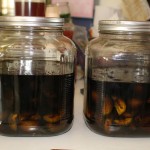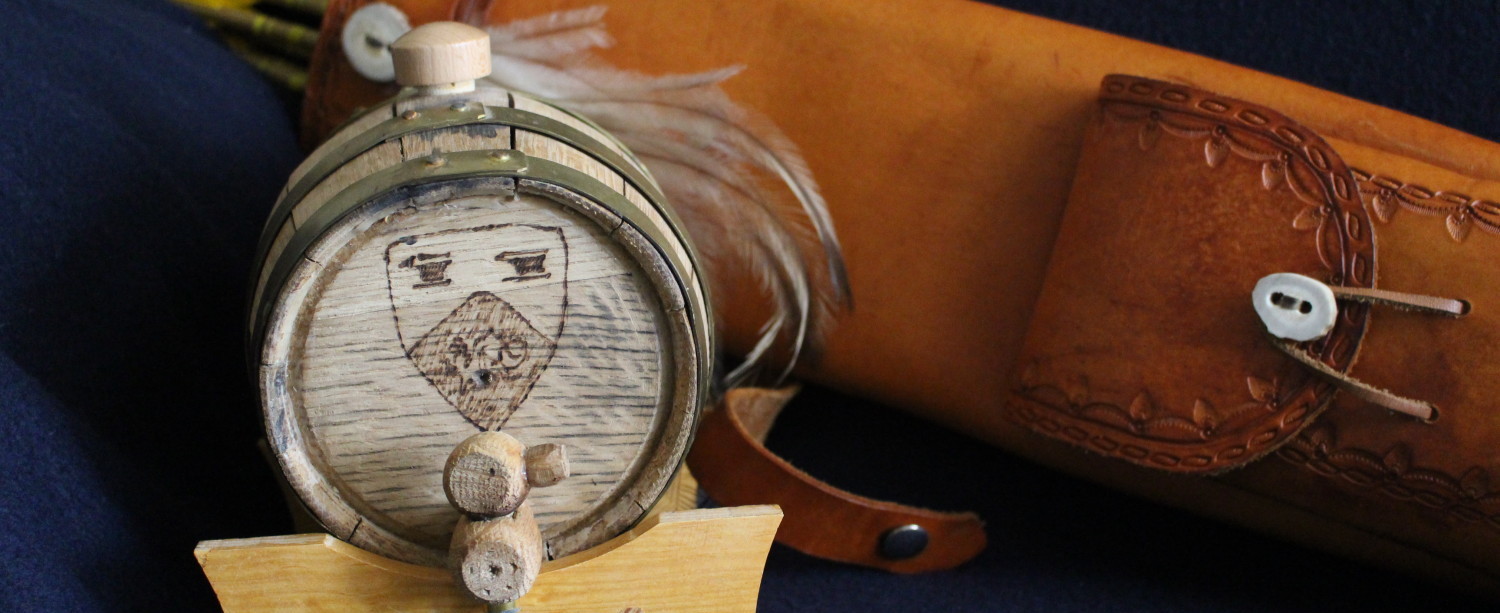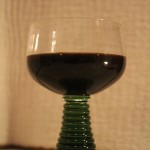Nocino – Part VI
The Science of Nocino (part 6)
OK, I need to finish up this treatment of the Science of Nocino. When last we met, I was discussing some of the findings from research on the best time to harvest walnuts for nocino and what those unripe walnuts contain from a chemical analysis.
Jakopic, et al (2007) replicated previous research that demonstrated earlier harvest to be superior to late harvest of unripe walnuts (June 30 vs. July 7) with respect to  overall phenoic content of nocino. They also investigated a variable that probably wouldn’t have been an issue in the Middle Ages: the differences between two different cultivars of the Juglans Regia: Frankette and Elit. Frankette was a better choice due to its phenolic profile.
overall phenoic content of nocino. They also investigated a variable that probably wouldn’t have been an issue in the Middle Ages: the differences between two different cultivars of the Juglans Regia: Frankette and Elit. Frankette was a better choice due to its phenolic profile.
In another study, Jakopic, et al (2008) found that infusing in a 40% alcohol solution was superior to infusing in a much higher alcohol solution (96%). Without getting into all the details of the phenolics involved, the study found that the best phenolic profile resulted from the lower alcohol concentration. This, too, is probably significant for the connection of the modern research to the Middle Ages. It is likely that the alcohol content of Middle Ages was considerably lower than the 96% and closer to the 40% based on my reading about distillation.
Finally, Cosmulescu, et al (2014) investigated phenolic profiles of green walnuts in 70% and 40% alcohol solutions. However, they added another condition in which the infusing of the walnuts occurred in a 40% alcohol and sugar solution. As expected, the higher alcohol content led to the highest extraction of phenolic compounds. They concluded that the 40% alcohol and sugar solution was a reasonable alternative because its profile of phenolics was better than a 40% alcohol solution by itself.
So, what do I take away from this research? The traditionally “best” time to harvest green walnuts on the Feast of St John (June 24) seems to be an ideal time according to the research. Harvesting by June 24 and possibly even a little earlier yields preferable levels of phenols and easier walnut slicing due to the walnut shells being softer. Even a couple of weeks after the 24th seem to reduce phenols significantly and increase the force necessary to slice the nuts. This seems to apply to the European climates where nocino is a traditional beverage. Other climates may differ. The walnuts I purchase from California arrive at my doorstep in late May. Based on my experience with those, I suspect that waiting until June 24 to harvest California walnuts would yield nuts whose shell is too hard to cut.
It also appears that a moderately strong (40%) alcohol content works well for infusing the green walnuts. While higher percentage of alcohol volume may extract more phenolic compounds, the more modest 40% solutions used in several studies seems to work out quite nicely in a finished product. Many recipes found online suggest using very high volume steeping agents (e.g., Everclear). Using a standard neutral spirit such as vodka should work very nicely instead of the brain-numbing high volume solutions. As I mentioned earlier, my reading of the early distilling methods suggests that walnut liqueurs made in “Period” likely contained something similar to the lower alcohol solutions mentioned in these studies.
I am looking forward to my batch of green walnuts that will arrive in late May. I really want to see the effects of three different infusion solutions: vodka (as my standard), grappa, and red wine. Should be fun!!!
Sources
Cosmulescu, S., Trandafir, I., Nour, V., Ionica, M., & Tutulescu, F. (2014). Phenolics content, antioxidant activity and color of green walnut extracts for preparing walnut liqueur. Notulae Botanicae Horti Agrobotanici Cluj-Napoca, 42, 551-555.
Jakopic, J., Colaric, M., Veberic, R., Hudina, M., Solar, A., & Stampar, F. (2007). How much do cultivar and preparation time influence on phenolics content in walnut liqueur? Food Chemistry, 104, 10-105. doi:10.1016/j.foodchem.2006.11.008
Jankopic, J., Solar, M., Colaric, M., Hudina, R., Veberic, R., & Stampar, F. (2008). The influence of ethanol concentration on content of total and individual phenolics in walnut alcoholic drink. Acta Alimentaria, 37, 233-239.


Have you any update on your nocino? I wondered how your new batches came out and how the oak aging test went.
I plan on making nocino for the first time this year. So I am trying to learn all I can.
Thanks.
Greetings, Brad!
I’m glad to hear that you are going to mix up some nocino! I oaked a very small sample of my earlier batches. It was an uncharacteristically crude approach (no measuring, etc.). I threw a few oak cubes into a small amount of nocino and tasted it occasionally. I liked the flavor. I bought several types of oak cubes with different chars to perform the “oak experiment” (outlined in Nocino IV) but I’m afraid that I got caught up in the steeping media experiment (vodka, grappa, brandy, red wine) and have not further addressed oaking. I have also worked with two friends on nocino cheese and vinegar experiments.
So, I don’t have any additional info to provide you on the oak front. 🙁 I can report that the steeping media experiment was quite a success.
Feel free to keep me updated on your progress. I’d love to hear how your nocino turns out!
Thanks so much for the quick response. Hearing that tests went well is exciting. I checked the walnuts trees this morning and the buds are starting. I will be making 2 or 3 small batches trying different techniques. Your blog has been very helpful. I should have results in a year! Thanks again.
Eynon,
Can I bother you with a question? I set up 4 jars of walnuts soaking in alcohol. I do not like vodka, so I used Everclear 151. But I want to reduce the alcohol amount to closer to 80 proof, so for 2 of the jars I added water, and to 1 jar I added red wine. 1 jar is is the pure 151 ever clear. The question is that the 2 jars with water have not really turned a dark color. The 1 with wine is darker, but I think a lot of it is the wine. The 1 in pure everclear is black. It has only been 12 days – but did I mess up with the ones with water and wine? Or you think time is all that is needed? Thanks.
Brad,
I’ve not added water to any of my batches, but I have heard that some folks do so. Most of the time, the liquid with the walnuts turns black quite quickly. At this point, my recommendation is to give the jar a little swirl each day and keep an eye on it. I would let it steep for the same length of time as the others and see what happens in the end. I suspect it will be fine. I am currently typing this in my Medieval wall tent while at Lilies War (an SCA event). When I get back to real life, I’ll see if I can find references to the addition of water.